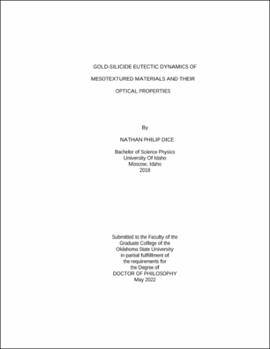| dc.contributor.advisor | McIlroy, David | |
| dc.contributor.author | Dice, Nathan Philip | |
| dc.date.accessioned | 2023-03-23T20:30:19Z | |
| dc.date.available | 2023-03-23T20:30:19Z | |
| dc.date.issued | 2022-05 | |
| dc.identifier.uri | https://hdl.handle.net/11244/337161 | |
| dc.description.abstract | Meso scaled pyramidal and inverse pyramidal structures, hereon referred to as Mesopyramids and Inverse Mesopyramids, are observed on Si[100] post annealing of a tri-layer of gold and silicon thin films. The structures are striated with a stochastic distribution of nano scaled plateaus and cavities. The cavities are on the order of tens of nano meters deep with a width up to a single micron. Growth of these pyramids is governed by the behavior of a eutectic under vacuo during annealing. The lattice structure of substrate plays an active role in the orientation of the array of mesopyramids on the silicon wafer. A native oxide promotes a wetting environment and acts as a barrier to diffusion of the eutectic into the silicon reservoir of the wafer. The quenching stage of pyramid fabrication initiates a final phase separation that results in the observed texturing. Dimensions of this texturing create optically active surfaces both in the far and near field. Diffraction patterns were generated with a beam of well collimated P-polarized light illuminating the concavity of the structures and the effect of the pyramid’s rounded edges. Calculating the radius of curvature allows for these structures to be modeled as spherical mirrors and explains the magnification or minimization of the Fraunhofer pattern produced. This square aperture effect also facilitated the creation of a mathematical model which is in good agreement with the physical results. Performing near field analysis allowed for the confirmation both visually and spectrally of the effective coupling of energy from photons to surface plasmon modes. This energy is observed to propagate as surface plasmon polaritons in the cavities of the mesopyramid and down an individual facet for the inverse mesopyramid. The spectral data obtained confirmed the presence of band transitions for gold from d-band to sp-band at 550nm and 650 nm wavelengths of light. Back scattered light from theses surface plasmon polaritons is analyzed as the average of the behavior at the gold-silicide dielectric interface. The opportunity to further develop these surfaces into optoelectronic devices as well as metalens materials provide impetus for this body of research. | |
| dc.format | application/pdf | |
| dc.language | en_US | |
| dc.rights | Copyright is held by the author who has granted the Oklahoma State University Library the non-exclusive right to share this material in its institutional repository. Contact Digital Library Services at lib-dls@okstate.edu or 405-744-9161 for the permission policy on the use, reproduction or distribution of this material. | |
| dc.title | Gold-silicide eutectic dynamics of mesotextured materials and their optical properties | |
| dc.contributor.committeeMember | Borunda, Mario | |
| dc.contributor.committeeMember | Meyers, Derek | |
| dc.contributor.committeeMember | Yost, Andrew | |
| dc.contributor.committeeMember | Ohara, John | |
| osu.filename | Dice_okstate_0664D_17590.pdf | |
| osu.accesstype | Open Access | |
| dc.type.genre | Dissertation | |
| dc.type.material | Text | |
| dc.subject.keywords | binary phase separation | |
| dc.subject.keywords | eutectic dynamics | |
| dc.subject.keywords | gold silicide | |
| dc.subject.keywords | nano | |
| dc.subject.keywords | surface plasmon polariton | |
| thesis.degree.discipline | Physics | |
| thesis.degree.grantor | Oklahoma State University | |
